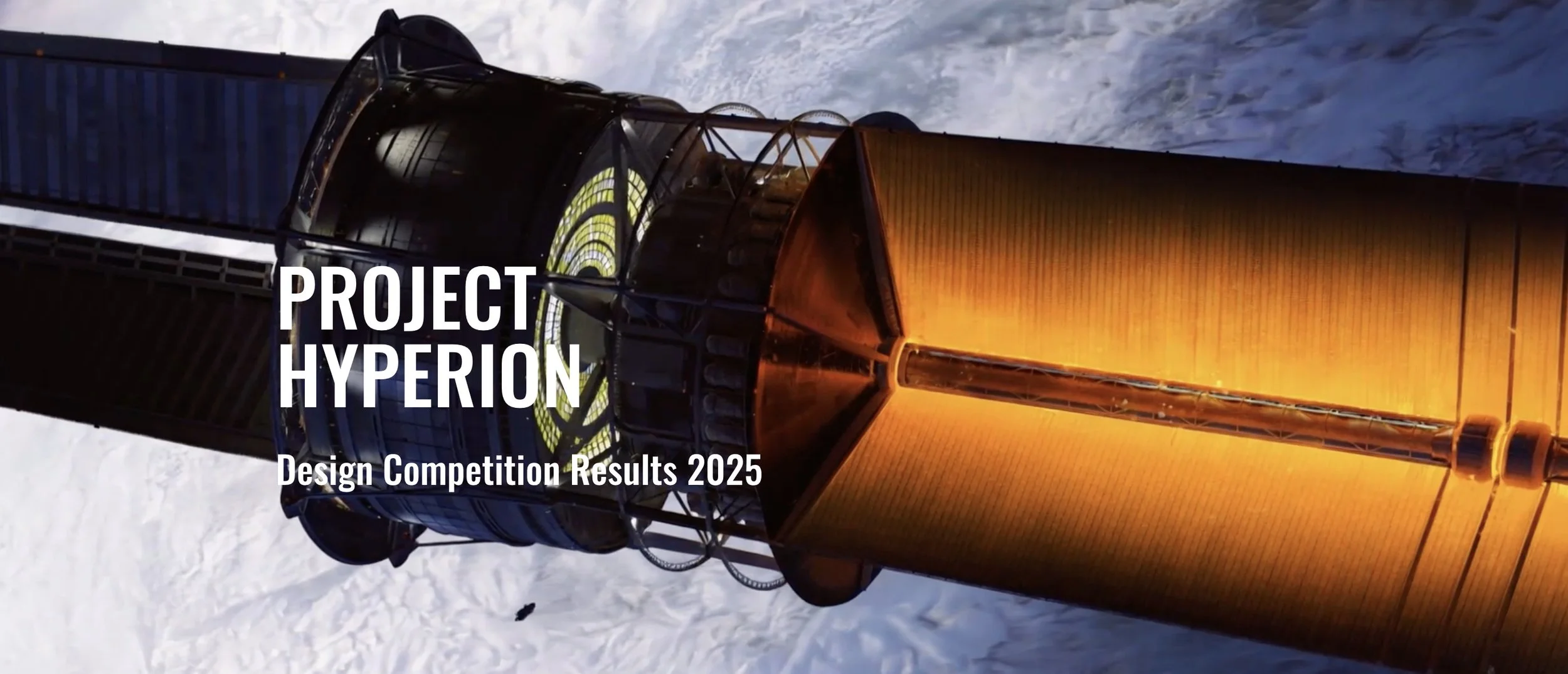Project Hyperion: A Global Design Race Turns Interstellar Dreams into Near-Term Market Signals
Credit: Initiative for Interstellar Studies (i4is)
Competition as a catalyst for innovation—and a bridge to space life
Project Hyperion is an international design competition run by the UK-based Initiative for Interstellar Studies (i4is) to answer a deceptively practical question: if you had to design a generation ship that keeps 1,000 ±500 people alive, productive, and culturally coherent for ~250 years, what would you actually build—with current or near-future technologies? The brief requires credible artificial gravity, closed-loop life support for food, water and air, and knowledge-transfer systems for a society that must thrive without resupply. In July 2025, Hyperion announced its winners, showcasing concepts that marry architecture, engineering and social science in unusually concrete ways.
The competition’s objectives are explicit: produce integrated concepts that test the feasibility of crewed interstellar flight, guide future research agendas, and inform the public—turning speculative fiction into auditable design choices. i4is frames Hyperion as part of a longer arc to make interstellar studies a serious technical discipline, not a thought experiment. That means focusing on systems we can start prototyping now (habitats, radiation shielding, rotation-based gravity, bio-regenerative life support), then iterating as materials, power, and automation improve.
How it started and what they’re trying to achieve
Hyperion launched on November 1, 2024 as an open, two-phase challenge with a $20 registration fee and a $10,000 prize purse (1st: $5,000; 2nd: $3,000; 3rd: $2,000). Teams were required to be interdisciplinary—at least one architectural designer, an engineer, and a social scientist—so that structural loads, crop cycles, and social norms get designed together rather than bolted on. The Phase-1 to Phase-2 funnel kept the focus tight and the review load realistic.
Hyperion’s rules force entrants to confront the hard edges of “forever hardware”: how to spin for gravity without intolerable Coriolis effects, how to shield radiation without unbuildable mass budgets, how to sustain farming and waste loops for centuries, and how to encode governance and education so knowledge doesn’t decay. The winners illustrate the range: “Chrysalis” (1st) offers a modular cylindrical habitat with in-space manufacturing and pre-mission crew preparation; “WFP Extreme” (2nd) emphasizes cultural and social systems with counter-rotating rings; “Systema Stellare Proximum” (3rd) explores an asteroid-shelled habitat inspired by biomimicry. These aren’t paper sketches; they’re coherent architectures that can be decomposed into near-term research work packages.
This is competition as an R&D catalyst; a fuel for innovation (and talent). i4is set measurable targets—population, gravity, closed loops—and let the world’s talent self-organise around them. Coverage from mainstream outlets underscores that Hyperion didn’t simply reward visuals; it rewarded systems thinking tied to plausible tech stacks. That public scorekeeping attracts global talent and gives universities, studios, and early-stage companies a portfolio piece that industry can interrogate and fund.
As a UK-registered not-for-profit company limited by guarantee, i4is organises the competition and administers prizes and reviews. The terms codify the purse and the two-phase structure; the organisation’s broader strategy is to build a sustainable institute that catalyses interstellar research and—importantly—supports a sustainable space-based economy over the long haul. This positioning is explicitly about boosting the UK’s role as a convener and standard-setter, while operating as a global network.
Innovation direction—and why this matters for commercial space
Hyperion is not about launching a starship next decade. It’s about derisking the building blocks that commercial space needs now and in the 2030s: robust closed-loop life support for private stations and lunar bases; artificial gravity architectures for long-duration health; radiation shielding strategies relevant to cislunar logistics; and social/operational playbooks for crews living under tight resource constraints. Each is a line item investors and operators already care about as LEO and cislunar markets mature. A competition that forces teams to integrate these subsystems produces transferable IP—requirements, interfaces, testable assumptions—that can be lifted into orbital habitat design reviews and procurement packs.
It’s a prize lineage that works. Hyperion follows a model proven to unlock private capital and compress timelines: set a clear bar, publish the rules, and pay for outcomes. The Ansari XPRIZE did this for reusable crewed suborbital flight, catalysing a wave of private investment after SpaceShipOne met the spec—twice in two weeks. Hyperion adapts that logic to multi-disciplinary habitat design, which is arguably the harder coordination problem.
Commercial lens—how buyers and backers can use Hyperion outputs now
If you run a station program, a cislunar cargo business, or a life-support startup, Hyperion gives you benchmarked concepts to mine for subsystem requirements and risk registers. The public artifacts (design briefs, jury feedback, winner statements) are ready-made source material for internal roadmaps and proof-of-concept briefs: e.g., spin-hab mockups to study vestibular effects; radiation mass-budget trades using regolith or water; farm-loop pilots with quantified yields and failure modes. Because the competition required current/near-term tech, the step from poster to fundable work package is shorter than in typical speculative studies.
What this means for the UK. By hosting and curating Hyperion through i4is, the UK positions itself as a neutral hub for interstellar-adjacent R&D—complementary to national agencies and attractive to global teams. i4is’s founding materials frame a century-scale ambition that links research, education, and enterprise; competitions like Hyperion make that ambition legible to universities, startups and philanthropic funders looking for tractable problems and visible outcomes. That’s a credible way to grow UK influence in advanced space infrastructure without waiting for a mega-mission.
The through-line: competition turns a fuzzy frontier into priced, auditable problems. Hyperion’s constraints (population, gravity, loops) and its public selection produce designs that industry can argue with, borrow from, and—crucially—prototype. That’s how you make space commercially accessible: start with questions buyers will pay to answer, let the world compete to answer them, and carry the best ideas from the podium into the lab and onto the manifest.
